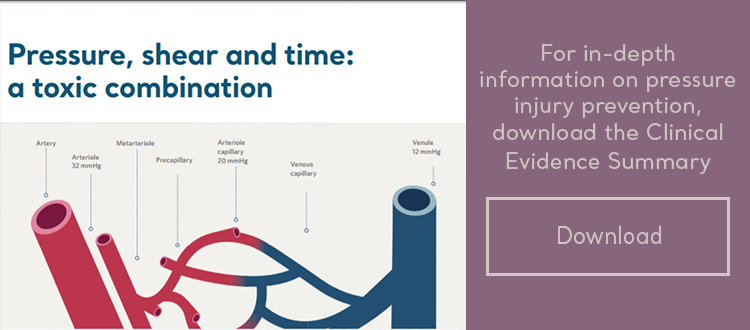The occurrence of pressure injuries is not limited to acute settings. Anyone can potentially develop a pressure injury.
The main causes of pressure injuries, also known as pressure ulcers, are pressure, shear and microclimate. However, other factors such as age, mobility, obesity, medication and malnutrition all affect a patient’s susceptibility to developing one.
Whilst it is not possible to eliminate or address all pressure injury risks, there is a need to prioritise the interventions most likely to have the greatest impact on clinical outcomes. Managing pressure, shear and microclimate are critical to this.¹
Support surfaces
Patients at risk of pressure injury development should be allocated a support surface for their bed or chair which specifically meets their individual needs. It is important to match the right surface to the right patient at the right time, according to clinical need. While the collective features of a support surface may vary, all redistribute pressure either by generating a constant low pressure environment (reactive surface) or by periodically lowering pressure through the deflation of alternating air cells (Active surface). In addition, many surfaces also feature an inbuilt microclimate management (low air loss) system designed to reduce temperature and moisture build up at the interface between the support surface and the skin.²

Repositioning as a pressure injury prevention tool
Caregivers understand the importance of repositioning patients to reduce pressure injury risk. Regular repositioning in conjunction with a suitable support surface, can also relieve discomfort for patients.³
![]()
Postural change is not without risk to both patient and caregiver, so it’s vital that correct patient handling or lifting equipment is used.⁴ Unless contraindicated, repositioning is a vital pressure injury prevention tool.⁵
Support surfaces play a vital role in the prevention of a pressure injury. It is also clear that regular repositioning, where possible, helps reduce the risk of, pressure injuries. The combination of prevention techniques should be tailor made for each patient, taking care of their specific needs.
References
- 1st: Phillips L. Support surfaces: taking the pressure out of pressure ulcers. British Journal of Nursing. Ed Cowan T. MA Healthcare Ltd, 2014.
- Clinical Evidence Summary – Pressure Injury Prevention Solutions. page 6
- National Pressure Ulcer Advisory Panel, European Pressure Ulcer Advisory panel and Pan Pacific Pressure Injury Alliance. Prevention and Treatment of Pressure Ulcers: Clinical Practice Guideline. Emily Haesler (Ed.). Cambridge Media: Osborne Park, Western Australia; 2014. Page 89
- National Pressure Ulcer Advisory Panel, European Pressure Ulcer Advisory panel and Pan Pacific Pressure Injury Alliance. Prevention and Treatment of Pressure Ulcers: Clinical Practice Guideline. Emily Haesler (Ed.). Cambridge Media: Osborne Park, Western Australia; 2014.
- Phillips L. Pressure ulcer prevention: keep it safe, keep it simple. In: Duffy V, Lightner N (eds). Advances in Human Aspects of Healthcare. Proceedings Applied Human Factors and Ergonomics: USA. 2014; 3: 19-24.
